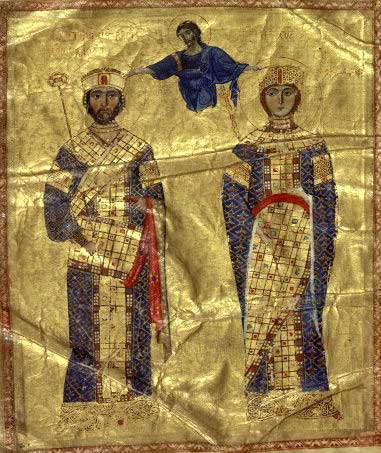|
|
The Byzantine emperor Nicephorus III and Maria of Alania. Source Bibliothèque nationale de France Manuscript Coislin 79 folio 2 bis verso 1074 / 1081 . Author in Homélies de Jean Chrysostome (John Chrysostom Homilies) Empress Maria (ca 1050 – after 1103) was a daughter of the Georgian king Bagrat IV (1027–72) and spouse of the Byzantine emperor Michael VII Ducas and later also Nicephorus III Botaniates. She is frequently known as Maria of Alania in apparent confusion with her mother Borena of Alania, the second wife of Bagrat of Georgia. Born princess Martha of Georgia, she was sent to Constantinople to be brought up and educated under the patronage of the empress Theodora in 1056. The latter, however, died the same year and Martha returned home. She married in 1065 Michael, a son of Constantine X Ducas, and the future emperor. In 1078, a palace coup ousted Michael and enthroned Nicephorus III Botaniates. Maria agreed to marry the new emperor provided her son, Constantine Ducas, would be declared an heir apparent. Nicephorus subsequently violated his promise, and the empress became involved in a plot organized by the general Alexius Comnenus who was rumored to be her lover. Alexius forced Nicephorus to abdicate the throne and was himself crowned the emperor in 1081. Alexius had Constantine proclaimed heir to the throne. Later Alexius betrothed his daughter, Anna Comnena, to Constantine. The situation changed, however, after John II Comnenus was born in 1087: Anna’s engagement with Constantine was dissolved, the latter was deprived of his status of heir apparent and Maria forced to retire to a monastery. Constantine died a teenager in or around 1096 and Maria’s involvement in politics was finally terminated. Maria was renowned for her beauty and education. She had a frequent correspondence with the noted theologian and philosopher Theophylact of Bulgaria, who is said to have been inspired by the empress when writing his principal work Explanations to the Gospel according to John. Maria also patronized Georgian monasteries in the Balkans, especially the famous Iveron Monastery on Mount Athos. She joined also her mother, Borena, in building the Kapata Monastery on Mount Sion at Jerusalem.
References
Links Retrieved from "http://en.wikipedia.org/"
 |
|
|||||||||||||||||
